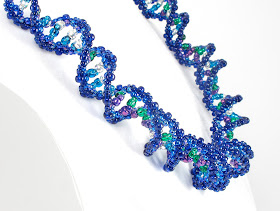A few months ago Gwen Fisher published a video using Doceri software on how to weave a pair of DNA double helix earrings using seed beads and thread. As a molecular biologist by training, I was completely enamored with this design and immediately set out to play with it (all the while kicking myself for not coming up with the idea first!), but I've only now gotten around to writing the first of what will be several posts on my variations on this pattern. If you haven't already seen her free video on how to make your own pair of DNA earrings, check out Gwen's blog for all the important details.
I first tried this design on a short random sequence of eight base pairs:
I managed to get the design to work the first time, using significant tension in the second and third rounds of the design to get it to twist. The helix actually started to twist while I was beading the second round.
After trying out this pattern, I immediately wanted to modify it to make it look closer to the structure of real DNA The biggest difference between this design and a DNA double helix is that the bases, consisting of A, G, T, and C, are on the "rungs" of the DNA ladder, not on the sides.
The image above shows the chemical structure of B-DNA, the most common form of DNA. The bases are the flat ring structures containing the blue nitrogen atoms. The thymine and cytosine, or T and C bases, are called pyrimidines and have only one ring. The adenosine and guanine, or A and G bases, are purines, contain two joined rings, and are therefore somewhat bigger than the pyrimidines.
Each side of the DNA ladder, what we call the "backbones" of each of the two DNA strands that make up the double helix, is made up of a repeating sequence of sugars and phosphates. You can see in the image above that there is one sugar (the non-flat ring next to each base, containing no nitrogen or phosphorus) and one phosphate (made up of yellow phosphorus and red oxygen atoms) for each base. Therefore, the important genetic material in DNA is confined to the inner part of the structure.
One other important feature of DNA is that, except in rare cases, A will always pair with T, and G will always pair with C. This is why DNA sequence databases such as the public National Center for Biotechnology Information will list the sequence of only one of the two strands; if our sequence is:
AGCCATATGAC
..we can match each base in the sequence with its partner to get the sequence of the other strand:
AGCCATATGAC
TCGGTATACTG
I tried to incorporate this aspect of DNA to modify Gwen's design to use color-coded twisted 6 mm bugle beads for the base pairs. I also changed the colors of the DNA backbone to solid blue for the 15° and 11° seed beads, and capri blue for the 8° seed bead, to try and mimic the repeating sugar-phosphate structure.
From a beadweaver's point of view, the structure works up and holds its twist just as well as the original. But the molecular biologist in me really wanted to see all four types of those bases.
So I switched to 8° seed beads in place of bugle beads for the bases; two seed beads for the purines, and one for the pyrimidines, and also color-coded the 11° seed beads on either side to match its associated base (I also changed the backbone a little bit, but that's a topic for another post):
I like this arrangement much better. It results in a somewhat thicker helix, but it's much more biologically accurate. It would probably work better in a pendant or a cuff than in earrings.
Gwen also tackled this arrangement by using 8° seed beads and a 3 mm firepolished crystal for each base pair, resulting in a slightly larger helix.
I'm still not done creating further variations on this design, but those are topics for future blog posts. Next time I'll talk about DNA's major and minor grooves...
Have you ever tried incorporating ideas from your day job into your beadwork? How did it work?






















































